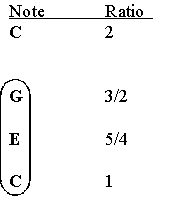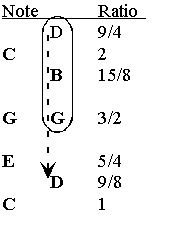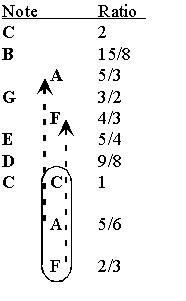
3.8 New Scales and the Development of Western Harmony
Even though Pythagoras came up with a simple mathematical way of understanding the musical scale, not everyone agreed with his construction. In particular, the philosopher, Ptolemy, who lived around 140 A.D., was not happy with the Pythagorean scale. He felt that the intervals got too complicated.
Here again is the Pythagorean scale. One cannot really blame Ptolemy for saying that it was not so simple, after all.
|
Note |
Ratio |
|
Step size |
|
D |
2.000 |
2 |
9/8 |
|
C |
1.778 |
16/9 |
256/243 |
|
B |
1.6875 |
27/16 |
9/8 |
|
A |
1.500 |
3/2 |
9/8 |
|
G |
1.333 |
4/3 |
9/8 |
|
F |
1.185 |
32/27 |
256/243 |
|
E |
1.125 |
9/8 |
9/8 |
|
D |
1.000 |
1 |
|
As we saw before, there are only two steps in the scale. The whole step = 9/8 and the half step = 256/243. The ratio for the half step is not so simple and, even worse, two half steps do not equal one whole step.
To Pythagorasís credit, all fourths and fifths are perfect (i.e. they come out to 4/3 or 3/2 exactly). What about major thirds? The major third is a pleasing musical interval corresponding to F to A, or G to B on the piano. What is the major third in the Pythagorean scale? From the table above, we find that it corresponds to a ratio of (81/64) = 1.266. Moreover, all major thirds are the same.
However, Pythagoras was looking for simplicity! The octave, Perfect Fifth, Perfect Fourth and whole step came out to ratios of small integers. However, the major third and the half step were getting quite complex. Besides not having a simple ratio, the Pythagorean major third sounds bad. As a result, Pythagorasís solution to this problem was to simply ignore the major third! Also because of this, the Church even banned the use of the major third during the Middle Ages! This inhibited the development of Western music and harmony for a long time. At this time, Gregorian chant was developed, as it does not use the major third. Music without the major third sounds quite stark and open, characteristics of Gregorian chant.
Again, it was Vincenzo Galilei who pushed for a change in the definition of the major third that would allow for more complex harmony.
THE JUST SCALE
Back to Ptolomy: Ptolomy had a different idea of simplicity. He wanted all basic intervals to be simple, not only the fourth, fifth and octave. These are known as the Just intervals. So, instead of 81/64 for the major third, he chose the closest simple ratio, which is 5/4 = 1.250. Remember, Pythagoras formed all his basic intervals with the numbers 1, 2, 3, and 4. He did not want to go on to 5. However, it turns out that 5/4 is really the natural way to define the major third.
Ptolomy also noticed that starting from the first note in the scale, going up a third and then a perfect fifth gives the frequencies, 1f, (5/4)f, (3/2)f. Or, to put it a different way, this group of three notes are in the ratios of 4:5:6. In fact, this group of notes has a special name: the major triad. The major triad is perhaps the most familiar and important chord in Western music as it establishes the tonic or starting note of the scale and the key that the piece is in.
Interestingly, this sequence of 4, 5, and 6 is part of a harmonic series. So, if one plays a note with a complete harmonic series, it contains the frequencies, 1f, 2f, 3f, 4f, 5f, 6f. Ö With this definition of the major triad, we see that any note with a harmonic overtone series has contained with in it a major triad. This is why the major triad is so important musically. Moreover, this is also why it is so important to define the major third as 5/4. Otherwise, it would not fit into the harmonic series. The major triad is warm, rich and pleasing as long as it uses the Just major third. If played with the Pythagorean major third, it sounds quite bad, which is why the Pythagorean interval was rejected. We will return to this question of overtone series, tone quality and consonance versus dissonance in detail, later.
So, Ptolomy had good esthetic and musical reasons for wanting a different definition for the major third. But, how did he construct a musical scale? His goal was to preserve the harmony of the major triad, as this was the most important reason for introducing the new definition. To demonstrate his construction, letís start on a C and build a major triad. This gives us two new notes, E and G:

Just as Pythagoras built on the previous intervals, so did Ptolomy, meaning that he then added a major triad starting on G, with the same ratios. Also, if a note got too high or low, it would be adjusted by octaves, again, just like Pythagoras:

Finally, Ptolomy needed one more triad, which he arranged to end on C:

The final Just scale, including the individual steps on the scale is:
|
Note |
Ratio |
Step |
|
C |
2 |
16/15 |
|
B |
15/8 |
9/8 |
|
A |
5/3 |
10/9 |
|
G |
3/2 |
9/8 |
|
F |
4/3 |
16/15 |
|
E |
5/4 |
10/9 |
|
D |
9/8 |
9/8 |
|
C |
1 |
|
Notice how the Just intervals are much simpler than the Pythagorean intervals. This is what Ptolomy was after. Especially nice is the fact that all major thirds are simple and the same.
However, are there any new problems? The answer is emphatically, YES!
There are now two kinds of whole steps, 10/9 (major) and 9/8 (minor). Moreover, the half step is 16/15 and two half steps donít give either kind of whole step. Having two kinds of whole steps is a particularly bad characteristic for a scale, because then a keyboard, like a piano, can only be tuned to one key at a time. If you want to play a second piece in a different key, you must retune the entire instrument!
However, there is an even bigger problem: not all of the fifths are perfect! The interval from D to A, which should be a perfect fifth comes out to (5/3)/(9/8) = 40/27 = 1.481 instead of 3/2 = 1.500. This is very bad, indeed. After octaves, fifths are the most important interval, and it is very jarring to have them out-of-tune.
Is the Just scale better or worse than the Pythagorean scale? This is a difficult question to answer. Gregorian chant sounded just fine with the Pythagorean scale, so if this is the music you like you donít need the Just scale. However, the Pythagorean scale will not allow you to develop the more complex harmonies of Western music.
Just scale is based on three triads: the tonic, the dominant (the one built on the third note of the tonic) and the subdominant (the one whose third note is the tonic). Each of these triads has a particular role in Western harmony and the change from one to the next can be very pleasing and satisfying. These changes are called cadences and form the smallest unit in a musical composition.
As mentioned above, the biggest problem with the Just scale is that it is very hard to implement on a keyboard instrument like a harpsichord or a piano. The instrument had to be tuned differently for every key, which, of course, is very awkward. Harmonically, this is a big drawback, because it also means that any one piece must stay in the same key. So, even though more advanced harmony is possible, it could not be fully exploited because modulation was not possible.
THE EQUAL TEMPER SCALE
In the end, the Just scale was still not adequate for the composers now trying to extend the scope of Western harmony. To fix the problems of both the Pythagorean and Just scales a more drastic solution was found. Rather than build up the scale from intervals or triads, the octave was simply divided up into 12 equal half steps. Furthermore, the whole step was chosen to be exactly two half steps. This represents yet a different definition of simplicity! This scale is called the Equal Temper Scale, as each step is equal.
Now, for there to be exactly 12 half steps in an octave, it must be true that:
(half step)12 = 2 (Octave).
So the half step = 1.0595. Also, a whole step = (half step)2 = 1.123
Since the Equal Temper scale is based on half steps, we need to see if the intervals come out correctly. A fifth is made up of seven half steps, so in the Equal Temper scale a fifth is given by (half step)7 = 1.498. This is not exactly 3/2, but it is very close. It is much better than the imperfect fifth in the Just scale. Moreover, since all half steps are the same, all fifths will be the same.
Most importantly, in the Equal Temper scale, all keys are equal, even if no intervals are quite perfect! So, now a single piece could modulate from one key to another, as the keyboard did not have to be retuned for each key.
The great composer J. S. Bach got so excited about the new scale that he wrote a Prelude and Fugue in every major and minor key. He then played them straight through in a public recital to show off that fact that the harpsichord did not have to be retuned between every piece. It was probably as startling at the time as when talking pictures or color movies first appeared. In fact, Bach was so excited by all of this that he did it again Ė he wrote a second book of Preludes and Fugues in every major and minor key!